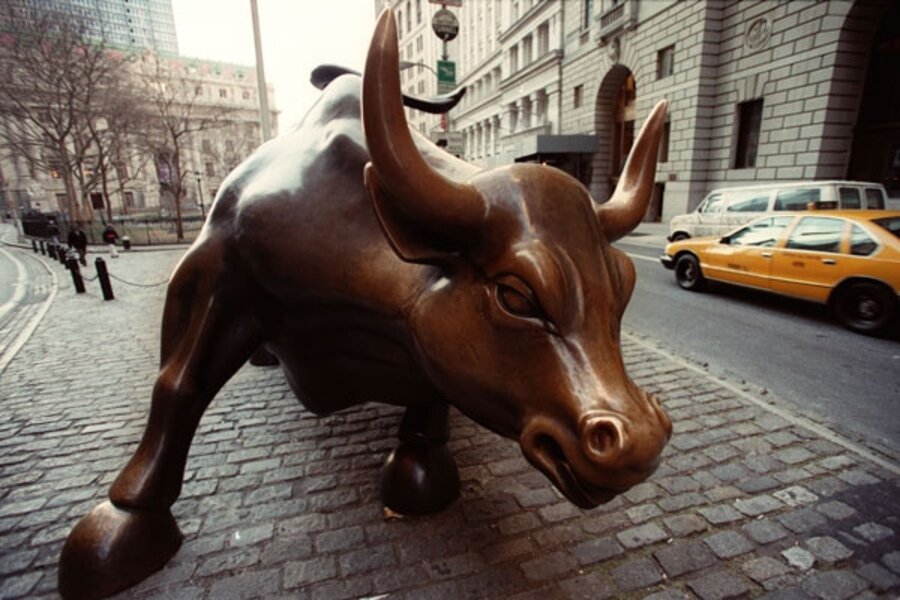Is the bull market back?
Loading...
| New York
Call it America’s stealth bull market.
Although many Americans are not aware of it, the stock market has been roaring since March.
The Standard & Poor’s (S&P) 500 index is up 58 percent from the lows of spring. And, for the year, the average is up almost 18 percent. According to Morningstar, a Chicago-based financial research company, the average domestic stock mutual fund is up 26.83 percent this year. And this week, according to the Federal Reserve, household net worth rose by $2 trillion in the second quarter, after falling for the prior seven quarters.
Snort! Snort! Snort!
Feeling better?
The good news on Wall Street is starting to slowly resonate on Main Street. The Gallup Organization asks consumers every night how they are feeling. “Our measures of consumer confidence are picking up, especially among upper-income people,” says Dennis Jacobe, chief economist for Gallup.
The readings are now as high as their best level in 2008.
There’s been a “grudging shift from irrational pessimism to grudgingly rational optimism,” says Fred Dickson, chief investment strategist at D.A. Davidson & Co., who has been making speeches and appearances up and down the west coast over the past three weeks. Some of the 450 people at a recent D.A. Davidson event in Lewiston, Idaho, seemed to be “feeling better” about their investments, he says.
“Individuals are starting to slowly wake up,” he adds.
Still, Mr. Jacobe says many people aren’t participating in the market run-up, after they got spooked last year and sold their stock holdings. “It’s consistent with people recovering and rebuilding their balance sheets,” he says.
Run-up not so surprising
Some of the doubts may revolve around the speed of the market rebound. But, Sam Stovall, chief investment strategist at Standard & Poor’s, says a double-digit rise is not unusual in the first year of a bull market, especially after a sharp drop in the previous year.
For example, in 2003, the first year of a long-run rising market, the S&P index rose 26.4 percent. In 1991, the year of another bull market start, the average was up 26.3 percent. Even in 1982, when the market did not turn up until August, the S&P was up 15 percent in five months.
It’s also not surprising that investors are gun-shy after losing anywhere from a third to a half of their nest eggs last year.
“There are still a lot of people who are willing to earn 0.3 percent or less in a money market fund to make sure their investments don’t drop in value,” says Robert MacIntosh, a portfolio manager at Eaton Vance in Boston. “But those people who stuck it out are getting a nice return this year.”
Mr. Dickson says there is some $3.5 trillion sitting in money market funds, which are the equivalent of cash.
“Every time we have a dip in the market, we see managers taking money out of those money market funds and putting them into the stock market,” he says. “That process still has a way to go.”
Consumers still cautious
But the improvement in the stock market and consumer confidence has yet to translate into Americans’ reaching into their pockets and buying goods and services.
So far, says Gallup's Jacobe, “there has been a complete decoupling of consumer confidence from spending.”
Even if stock prices rise this year, many people will gauge the economy on the basis of what’s happening in their workplace, he says. “On Main Street they are still worried about their jobs."
Does that mean Wall Street is moving too early?
Dickson, the investment strategist, doesn’t think so. He says the market usually moves in advance of the economy by four to six months. Economists now expect the third quarter Gross Domestic Product (GDP) – five months from the market’s lows – to show a gain of 3 to 4 percent. And some optimistic projections say that next year’s first quarter will see a 5 percent gain in GDP.
---
Witches on Wall Street?
Friday was "quadruple witching day" for the financial markets.
---
Follow us on Twitter.





